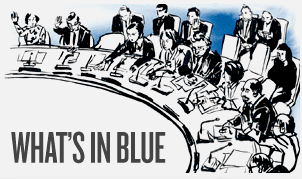Security Council to Adopt Annual Report
Tomorrow (Tuesday, 20 August) the Security Council is set to adopt the introduction to its annual report to the General Assembly covering 1 January-31 December 2018. Its drafter, the UK, is expected to present the introduction to the members. The introduction of the report is prepared under the coordination of the Council’s July presidency from the previous calendar year, except if the member holding the July presidency is to leave the Council at the end of the year; in such cases, the drafting devolves to the member next in English alphabetical order not leaving the Council at year-end. Sweden held the July presidency in 2018 but is no longer on the Council, and since the UK was alphabetically next, it assumed responsibility for preparing the introduction.
While all the versions of the Council’s working methods compendia known as “Note 507” state that the report is to be “adopted at a public meeting of the Security Council where members of the Council who wish to do so could comment on the work of the Council for the period covered by the report”, it has been extremely rare for members other than the drafter to speak at the adoption meetings. The format and the process of adopting the annual report–which the Council is required to submit to the General Assembly under Article 24(3) of the UN Charter–have undergone several modifications in the last quarter-century. The changes came in response to pressure from the UN membership, often called upon to implement Council decisions in matters such as peacekeeping and sanctions and wanting better insight into the Council’s work.
The current process for the preparation, adoption and presentation of the report was elaborated by the Informal Working Group on Documentation and Other Procedural Questions on the joint initiative of Lithuania and Russia in 2015 (S/2015/944). The content of that document was then incorporated, with some additional elements, into the most recent version of the comprehensive compendium of Security Council working methods, Note 507, issued as document S/2017/507.
As of 2017, the annual report covers the previous calendar year. The previous practice, since 1947, had been to cover a twelve-month period straddling two calendar years. The bulk of the document is a catalogue of thematically organised Council documents, prepared by the Secretariat. The introduction of up to 10,000 words is drafted by the designated member state. In the period since 2000, the length of the annual report has reached 587 pages, with the average being near 300 pages. The current report is over 200 pages. (For historical details on the annual report, please visit Security Council Annual Report to the General Assembly).
The 2017 Note 507 provided a series of deadlines for the report’s preparation process. It stated that the “introduction shall be completed no later than 31 January”, that the Secretariat should submit its portion of the draft by 15 March and that the report should be adopted by the Council in time for consideration by the General Assembly in the spring of the same year.
A key goal behind the most recent change in the process for elaborating the annual report was to allow more time for the General Assembly to discuss it. The practice in the preceding two decades had been for the Assembly to discuss the report during the busiest part of the session, in the last quarter of the year. Moving the debate to the spring was expected to give interested member states more time to study the report and prepare for the discussion.
The 2018 report is the third produced under the new procedure. In each case, finalising the report has taken much longer than stipulated by note S/2019/507: in 2017, the Council adopted the report on 9 August, and in 2018 on 30 August; the 20 August adoption in 2019 continues this pattern. The late adoption inevitably has pushed the General Assembly discussion into the very end of the session, when most delegations are already gearing up for the opening of the next session. The debates on the 2017 and 2018 reports were much shorter and the discussion less focused than previously.
Many delegations have long been concerned about the preparation and substance of the annual report, with speakers in the annual open debate on working methods urging the Council to enhance the timeliness of the report and increase the analytical content of the introduction.
There are most likely multiple reasons for the difficulties the Council faces in meeting its own aspirations with respect to the annual report. In addition to the now commonly encountered problems in reaching consensus on lengthy documents, a fairly new reason may be the current delays by Council members in producing assessments of their respective presidencies. These assessments, which have been submitted since July 1997 following the issuance of a 12 June 1997 presidential note (S/1997/451) on the annual report, constitute important primary material for the drafters of the introduction, but in the last few years, they have been submitted by several delegations with huge delays. At the time of the circulation of the 2018 draft report, out of the 12 presidencies that year, only four had submitted their assessments.
In July, a group of 25 member states known as Accountability, Coherence and Transparency (ACT) wrote to the president of the Security Council expressing their deep concern about the delay in the submission of the 2018 report (S/2019/582). The letter called on the Council “to expedite the adoption of the 2018 annual report” and “to submit the report to the Assembly in all working languages at least two weeks before the presentation, to facilitate the report’s substantive discussion”. The letter also urged the Council “to explore ways of strengthening the process through rigorous adherence to the time frame agreed to by the Council in the note of 30 August 2017”. ACT further suggested that “finding alternative ways to designate the delegation that should be drafting the report” might be contemplated.

